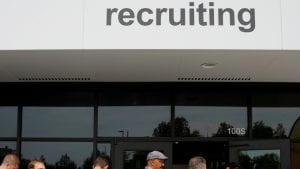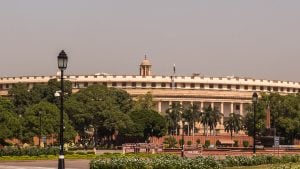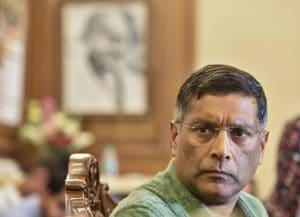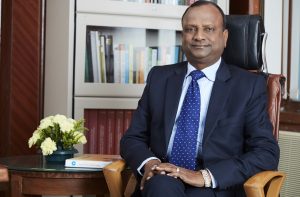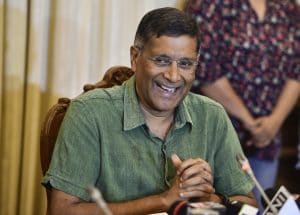Feel that 21 public sector banks may be too many, says SBI Chairman Rajnish Kumar

KV Prasad Jun 13, 2022, 06:35 AM IST (Published)
 Listen to the Article (6 Minutes)
Listen to the Article (6 Minutes)
Summary
Public Sector Banks are going through their worst phase. Almost all the banks reported losses during last quarter. SBI chairman Rajnish Kumar expects PSBs are capable of making a comeback and have a critical role to play for the next few years. At the same time he feels that 21 public sector banks may be too many.
After government said that there is no proposal for consolidation of government banks at present, country’s largest lender, State Bank of India, on Wednesday said that 21 public sector banks may be too many and there is a need for some consolidation.
Speaking to CNBC-TV18, Rajnish Kumar, chairman, said there must be a mix of large banks and niche banks in the country.
Watch: Need a strong asset management company, not an asset reconstruction company, says SBI Chairman Rajnish Kumar
According to Kumar, public sector banks are capable of making a comeback and have a critical role to play for the next few years.
He also said that banks and bankers need the confidence that decisions made on commercial grounds be protected and any action taken against them should be only on decisions taken with malafide intent.
Edited Excerpts:
Let me start by asking you about a development that has taken place today and that is the Chief Economic Advisor (CEA) Arvind Subramanian resigning for personal reasons. Now, two of the ideas that Arvind Subramanian had spoken about, one was a public asset rehabilitation agency for the lack of a better word it started to be called bad bank that was not taken forward and that idea in some form of fashion seems to be now back on the table in form of this national asset reconstruction company (ARC) or asset management company (AMC). I know a committee has been set up headed by Sunil Mehta, the PNB chief, to look at how this can be taken forward. How is this different from the idea of a bad bank that most people understand?
I think, the best is that we wait for a few more days, when the report of the committee comes out. Because, it’s comprehensively looking at all the issues. But yesterday, if you had heard the finance minister saying that, definitely we are not looking at setting up any bad bank. That he has clarified. So, the situation today is that there are a couple of ARCs and it is also not about setting up a new ARC. But there are various models available where it has been felt that we definitely need a strong AMC. The country lacks one. There are funds who have their own AMCs. But an AMC, which can manage, say for example, the assets in the power sector, it required specialised setup to manage these assets, if it was decided that we don’t want that they be referred to National Company Law Tribunal (NCLT) and there can be a resolution even outside the NCLT framework, because many of these assets there are power purchase agreements (PPA) available, even there is a fuel supply agreement. But still, they are not operating at the full capacity.
So in such a situation, if banks decided that these assets definitely need to be taken out of the banks books and we need a very strong agency, who can vanish these assets and that would mean the operators likes of say NTPC, or it can be Tata Power or it can be Sembcorp. There are couple of agencies who have the experience of running the large plants. The idea is that within two years or maybe even earlier, we may see a situation, where the demand for power and the generation capacity would be fully matched or rather there may be a shortage and at that stage, the value of these enterprises will be much higher when if banks do any distress sale today. So, this is a whole concept.
Is my understanding correct from what I hear from you that the priority at this point is to address the assets in the power space and so this ARC or AMC as and when it is taken forward will address these assets to start with?
May be that would be the good beginning point, but the idea ultimately would be that we have the capability to manage the stressed assets. Currently, the ARC structure, which is existent in the country, I am finding that structure is missing. So the requirement is not as much for an ARC, it may be, but there is definitely a requirement in the country for having an AMC.
You are saying not so much an ARC but in AMC- an Asset management company.
Asset management company and the alternate investment fund. The possible structure could be AMC, AIF and ARC. But these are all the thoughts, because these are coming from various people who are in the stressed assets resolution. Mehta, who has been appointed as the chairman of the committee to look into all this, he is consulting all the people including the existing ARCs that what should be the way forward. Because ultimately, the whole objective is that there are assets which can be resolved. An identification of those assets and then make a serious attempt to resolve those assets.
The chief economic advisor (CEA) had brought up this issue, this idea of a public asset rehabilitation agency and he had basically articulated it simply to suggest that politically tough decisions that are not possible to be taken will be taken by this agency, that will address stressed large assets so to speak. If it wasn’t though to be viable then, why is it on the table now, why is it now a viable solution to look at?
Let us not prejudge the issue, let us wait for about a week or ten days, when the committee draft report is ready. It has been discussed and some final recommendations have been worked out. It is idea only under examination at this stage, there is no final conclusion, no final decision.
The point is that this was an idea under examination for a while. So, if it wasn’t thought to be viable then, why is it being thought to be viable now?
What I am saying is that, if you ask me as a State Bank of India, I has certain assets and there are assets in different categories. They are assets, which we believe that can be resolved. There are certain assets, which we believe cannot be resolved. So, I have not studied in detail the concept, which was put by the CEA. However, whatever will be done or is proposed to be done or whatever will be our suggestions to the committee, it would be that everything will be within the regulatory framework. There are existing regulations, there is a framework, which has been given by RBI, as late as February 12. Earlier also, there were rules and regulations around how the ARCs work, how the alternate investment fund works and there are Securities and Exchange Board of India (Sebi) guidelines. So, whatever are the regulatory guidelines and the law, within that law, there is a need felt for someone, who is specialising in resolution of assets, which currently as a bank I believe is not happening.
As and when we see the recommendations of the Mehta Committee being submitted to the government and you expect them in another week or 10 days, what is a realistic timeline if the government were to go forward with either and ARC or an AMC, you prefer an AMC as you just told us but what is a realistic timeline of setting this up and getting it going?
That will also come within that report. The government is only acting as a facilitator in the whole thing and it would be a collective wisdom and effort of all the banks. As I said, no new legislation will be required, probably no new guidelines will also be required. So, it will be all within the existing framework.
So, if government plays facilitator, what about funding? How much will banks have to contribute to this AMC?
That is what will be decided. Whatever is done, there will be definitely be an arm’s length between this AMC or the fund and the banks. The risk appetite of all banks is different. Second issue, it has to be very clear that this AMC works at arm’s length from the existing banks and their stressed assets. If suppose, I want to invest today as a State Bank of India in a special situation fund, what is my risk appetite, what is my investment policy about these investments, that will determine who much I decide to put in there. Today, the difficulty is that if there is a stressed asset and there are 26 banks dealing it, even building a consensus around that itself is difficult. So, if that consolidation can happen through this route, then the decision making itself will be much faster and the responsibility for running the assets will shift.
What about pricing of these assets that this national ARC or AMC will take in?
As a banker, my take is that it has to be a transparent discovery of the price. There are methods available through which you discover asset, it will not even be mandatory for any bank to necessarily park assets with the new AMC. So, you have to discover price in a transparent manner. Whatever the recommendations would be, it would be all within the existing regulatory framework.
Since you are saying that there will be no need for any new legislation, no need for any new regulation realistically, how long before we can actually see this take off?
Take off maybe, I think, it can be done very fast, because there are various options again. So, it can be very fast, but when do we see the first asset being transferred to the new AMC, it may take minimum three to six months.
Three to six months before we actually see an AMC being operationalised. Since we were addressing the power issue and you said that you believe that maybe the stressed power assets will be the first to move to this AMC as and when it is operationalised. There is another meeting that will take place of the government with power sector stake holders tomorrow. A meeting that was scheduled today of the parliamentary standing committee has been postponed. We don’t know what the government’s response is eventually going to be to the Allahabad High Court order. Where do things stand as far as the power sector is concerned? The SAMADHAN plan, what is the current status?
There are several elements to SAMADHAN, which is a plan which was thought of by State Bank of India and there are various steps. So, they all are in progress including determining the sustainable debt, technical evaluation of all the plants by the NTPC, so all that work should be done within this month. That is what we are expecting. There are not many plants, we have identified only 11 and out of which nine seems to be the prime candidate for this resolution plan.
In any case, secretary, department of financial services (DFS), has been entrusted this task by the Allahabad High Court, so he will do his process and I am sure that he will be conveying the meeting in next couple of days, where again the views of all the stakeholders including the independent power producer who have gone to the court, the secured creditors, lenders and the discoms. So I think, he will be consulting widely with all these people and will able to finalise his recommendations and give it to the Allahabad High Court.
Obviously you cannot pre-empt what the government will chose to respond to the Allahabad High Court order. Let me ask you, since you spoke about these 11 stressed assets. How confident do you feel given the current context both in terms of power demand which is picking up as well as the supply constraints that we are faced with both on coal as well as the gas side that things are going to improve?
One is that, in this list there is nothing gas based. They are all thermal. They all are completed projects and they have PPAs either full or partial. But they are not operating at the full capacity, so that is why when the list was picked up and there was certain criteria and we have not touched any pant, which is say incomplete. We are not trying to attempt to revive it or resolve it. These are the plants, where we believe that with little bit of help, some support from the distribution companies, some forbearance on the part of the banks, again I am saying that everything we planned is all within the existing resolution framework and existing regulatory framework.
The only thing is that the Allahabad High Court have stated that February 12 guidelines of Reserve Bank of India (RBI) for this power plants. So, we have to see that when Secretary DFS submit his report to Allahabad High Court and what are the directions of the court. But these plants, the lenders believe that because they have PPAs and if they go to NCLT, there is potentially the economic loss will be much higher. When any generating company goes to insolvency, there are issues around even the existing non-performing assets (NPA), whether they get terminated or remain valid what would be the action of discoms under those PPAs, so the whole thinking and idea is guided by this fact that we should not allow value destruction.
Let me ask you a broader issue as far as NPAs are concerned and again it takes me back to Arvind Subramanian’s economic survey, where he identified the twin balance sheet problem or maybe at least put the governments attention firmly on the issue of the twin balance sheet problem. Quarter after quarter, bankers say NPAs have peaked and we are headed for better times now. Let us just take a look at where things current stand – bad loans have topped Rs 10 lakh crore, PSUs have written off Rs 1.2 lakh crore in FY18 versus Rs 81683 crore in FY17. Even for SBI, in 2017-18 you have recorded your highest NPA seen in over a decade. Is the problem really at its peak or is the worst yet to come?
As far as the NPA is concerned, I am firmly of the view that it has peaked. The level which has been achieved or which we have reached as on March 31, 2018 is the highest level. From hereafter, NPAs would start coming down. This is not what I am saying or any bank chief is saying, even if you look at all the reports of any rating agency or any analysis being done by anyone, they all have convergence on this point of view that from hereafter, the NPAs have to come down. I alone have Rs 78,000 crore of NPAs in NCLT one and two. If you look at the 180 days timeline, extended to 270 days, and even extended beyond 270 days, but by March 2019, all these have to be resolved one way or another.
Whatever we are able to recover, we recover. Whatever we cannot recover through this process, that is still to go out of the books of the bank. So, if my NPA was Rs 2,23,000 crore in March 2018, straight away Rs 78,000 crore has to go out of this by March 2019. This is all NCLT one and two alone. There are other accounts, where we will making recoveries. The gross slippage, the guidelines which I gave at the time of our earnings calls – it was about 2% of my advances portfolio, which is about Rs 40,000 crore. So, ultimately for SBI, there will be reduction in NPAs. As we are the largest in any manner, in anything including NPAs, so if that is the situation, with most of the banks that should hold true. So, unless something which we can’t foresee or I cannot foresee, if that something happens, then it is a different matter. But whatever I am seeing, it is based on the complete analysis of the loan book of the bank, the existing NPA, their recovery prospects and the fresh accretion of NPAs.
So, unless and until we see some black swan event, you believe that the trajectory should move lower from hereon?
Yes, at least from the gross NPA perspective. Some pain will still remain on provisioning front as the situation is different for each bank. For example, we have a provision coverage ratio of 66%, where we include our accounts under collection, which is below the line accounts and 50.5% on the Rs 2,23,000 crore. So, I would like this provision coverage ratio to go up. So, it means that maybe the profit and loss statement (P&L) will take one or two quarters more, because if I want to increase the provision coverage ratio, we will be more aggressive on provisioning. So, NPAs will come down, provision cover should go up, that is the trend I am foreseeing. So, the impact on P&L, that will be maybe for a quarter or so. It will be still there, because if 50% I want to take it ultimately to say 60%, I am looking at 10% more provision on the existing stock and whatever stock comes in there also, I would like to provide at a higher rate. So, ultimately if a bank’s performance like SBI or for any bank has to be seen, then it’s to be the strength in the balance sheet and not what profit you are declaring in June or what profit you are declaring in September.
So aggressive provisioning is expected over the next at least two quarters is what you are saying. On the NCLT and the IBC process, you talked about the first list as well the second list. We have seen those timeline extensions already but it looks like because of litigation etc. this process is going to be extended even further. A- is that concern for you? B – Really in terms of recovery how confident you feel outside of sectors like the steel sector for instance of being able to get anything that would be seen as value maximisation from a banks perspective?
Steel of course, because the sector outlook is so positive and fundamentally the assets, which were created they are very good, otherwise they would not have got as much value. But each asset is different and the realisation depends upon each asset one – what is the asset which has been created in terms of physical infrastructure. Second, is about what is the outlook for the sector. Because ultimately, any buyer, he will pay on the basis of what is the future earning potential for that asset? How much investment they have to make to improve the asset, so it is a very complex situation in respect of each asset. So there cannot be any thumb rule what so ever.
Ultimately, there is an asset which is available, it is available to anyone who wants to bid it. They will make their own assessment, but the major advantage of NCLT is that it takes into account or consideration the interest of all these stakeholders. That again and again Sahoo, Insolvency and Bankruptcy Board of India (IBBI) chairman, has also clarified. I have also clarified in several interactions that it should not merely be seen as a recovery for the secured creditors. It should be seen as a ways and means of reviving an enterprise keep it running because once an enterprise goes down under there is a huge ecosystem around it which also collapses. So, it is in nobody’s interest that an enterprise go down. It is in everybody’s interest that the enterprise value is protected or enhanced as much as possible.
That is where NCLT because, there are rules, there are rules around how the money would be shared, what should be the process and it has judicial scrutiny. So, I believe that this is a fantastic process. All countries follow it. Absence of it was being felt in the Indian financial system. So now, once we have this law, it is everybody’s responsibility to ensure and see that it works well. There have been recent amendments in the court again based on the experience so far. Certain rules are also to be drafted to ensure that the timelines are adhered to.
But I would not be unnerved, because it was first year and litigation in any case was expected. But as the law starts getting settled through amendments, wherever required based on the experience. The seriousness with which the government also has shown in the matter to ensure that the process stabilise as quickly as possible and the objective behind is fulfilled. I am quite optimistic, but as I said that, whether it is a contradiction where I am saying that power sector, I don’t intend to take certain assets to NCLT, so it is not an contradiction. So, banks or as a lender, we have to look at both of the options very carefully and if there is a possibility, that enterprise can be preserved or will give higher value outside the NCLT process, first, we should try that process.
Do you see, I mean you spoke specifically of the power sectors as a sector where you would like to stay outside of the NCLT process – nine, so that is a significant number out of the 11 identified stresses assets. Would you consider this option for other sectors as well?
Yes, very much and that is what the RBI framework also says, that in 180 days there may be debate around this, that whether 180 days is sufficient or one year is sufficient or 270 days is sufficient. But for large accounts like Rs 2,000 crore and above, what does the RBI circular says that in 180 days, if you can find a solution, which the lenders believe is better then implement it and if not then the NCLT route.
Today you feel confident that you will be able to take these nine stressed power assets outside of the NCLT for a resolution?
Today, I won’t make such a confirmed call, because still lot of work is going around that. Maybe, if you ask me this question three weeks down the line, we will have some clarity on this, today it will be pre-judging the issue.
Let me then talk to you about another issue and you have made a presentation to bankers in Mumbai and you made a presentation in Delhi as well, articulating your experience of consolidating the banks that you have been able to bring under your fold. Is it realistic to expect that, that can be extrapolated as the experience that other banks will be able to enjoy as well? Second, is this the right time to look at consolidation because most people that we have spoken to say that while it may be inevitable, this is not necessarily the right time given where banks find themselves as far as NPAs are concerned. So, why merge weak banks into weak banks and make a bigger weak bank is the argument against the idea of consolidation today?
Who said that there is any proposal to merge a weak bank with a weak bank? I don’t know from where this hypothesis is flowing. We have the tendency to pre-judge every issue. Last year, we merged six banks, five of which were from the same family. So, the experience which was for these five banks with SBI, it is not the same experience for other banks. However, what are the benefits, how it was done, what are the issues to be looked at, the presentation which was made was only to share that experience. This is what you always keep on doing that, if somebody has done something successfully just share that idea. After that of course each and every situation will be different.
I am not suggesting that the idea is to merge weak banks with weak banks but the industry as a whole finds itself in a difficult position, so given that context is consolidation the best way forward? Again it has not been decided will it be geographical consolidation that we are likely to see, region specific consolidation we are likely to see. What to your mind should be the way of looking at this? Whether this happens now or six months down the line, a year down the line, we don’t know but what should be the way of looking at this?
The one way to look at this is that do we need 21 public sector banks, that is the first question. So, unanimously bankers feel that maybe 21 are too many.
What is the right number?
There is no right number but 21 is too many. So, that much is consensus. What is the right number? That is something which needs to be decided. Running a bank in today’s environment, where the requirement of compliance, regulation, technology, capital and the owner is same. The capital is not unlimited, that capital gets fragmented, so is this the best optimal way of using a resource which is scarce? Technology, it requires lot of investment. Is it possible for smaller banks to not have technology and compete in this market or if they want to have technology, do they have the resources, management bandwidth to compete with likes of what is emerging today? The banks are becoming less of banks and more of technology companies. So, these are some of the broader issues.
When we look at it then, the path which comes out is that there is need for some consolidation for sure. The objective also has to be very clear, that we need a few banks, at least four to five banks. This was said by Narasimham Committee in 1995, that there is definitely a need for four to five big banks, who have a certain scale and who can meet the needs of the economy, which is growing very fast. The ambition is to be one of the largest economies, we should need to grow more than 8%. So a fragmented banking system cannot do. However, I am not saying that there is no scope for niche banking. Worldwide the experience is that in every country, you will have very large banks and then you have niche banks. So, it has to be mix. Our country is such a large country, we are 1.3 billion people, so I will always say that there is a scope for everyone. So, either you have scale or you have a niche, but cloning each other is no more an option. So, this is what the whole hypothesis is about, rest is all the matter of detailing.
In terms of detailing, again I ask you this what would be realistic to expect. I mean you said no decisions have been taken. But in discussion where do we find ourselves today. You said there is consensus on the fact that 21 public sector banks are not needed. Are there any other thoughts and ideas on which there is consensus on the way forward?
My role ends here.
The rest is up to the government?
Or the banks. We are not advising anything like we put this way. What we have done is that only the experience sharing of state banks merger and how it has been done. Merging five banks was not an easy task, even if they were part of the same group. So, that is only an exercise, where you share your experience and after that at that point state bank or my role ends.
And the government’s role begins. But let me ask you two specific questions since we are talking about the road ahead for PSBs. Market share what is down by about 5.5% in the last 10 quarters and a lot of people argue that there is malign neglect, when it comes to the public sector banking and the private sector banks are basically walking away with market share. In the current context, do you expect to see a recovery as far as market share is concerned? I mean forget consolidation, but in a business as usual environment do you really expect a recovery and improvement as far as market share is concerned?
I have a feeling, because last two years were particularly were very challenging for all the public sector banks and quite a few private sector banks also and in that process. The non-banking finance companies (NBFCs) have been able to do very good business and some business has gone to the private sector banks also. But public sector banks in my view, they will be and are capable of coming back. The process of whatever I have read in the newspaper and whatever is available in the public domain, government is very serious about appointing the high quality professional on the boards of the bank. They are in the process of filling all the vacancies. So that in my view, is the first step that let us have professional boards, let us have professional management and then they chalk out their plan.
Government yesterday again, I am quoting the finance minister, who has very categorically said that government is firmly behind the public sector banks and they will support all banks. But for that support, the banks will also have to do something and that is what is required, But the public sector banks have a very critical role for some more years to come and they will do that.
Let me ask you about capital requirement? I mean some experts suggest that in excess of Rs 2,73,000 crore to meet the Basel III norms etc. will be required. We have seen what the government is been able to provide by way of the recapitalization. Again that idea that was once was floated not taken forward the possibility of a holding company, has there been any conversation on bringing back that idea just like we brought back the ARC idea and the AMC idea?
No, I am not aware of that. As far as capital is concerned, there will be definitely multiple sources. One, all the banks in my view should be returning to profitability. Second, is they have their own internal accruals, all the non-core assets, all the banks are having a serious look and whatever they can offload, they will be offloading. So, whatever are the means available for the banks to internally raise the resources, so they have to act very systematically towards that and plus government support, budgetary support whatever is available, so this one will be a big infusion an Rs 65,000 crore. The numbers which you are saying is maybe about five year period or something like that. I am sure that each bank would have drawn their recapitalization documents. We have done for ourselves and we should be able to meet the capital adequacy requirement. For SBI, it is much easier, other banks who are below that threshold level for them, the government support is required.
I will end then by asking you, yesterday the finance minister Piyush Goyal said that there is no witch-hunt and that the government supports public sector banks and they should have no difficulty in lending. But on the ground what is the reality? Is there a feeling now that the decisions that will be taken today that maybe purely commercial decisions that may go bad tomorrow will be seen a mala fide and hence there is a hesitation and apprehension to lend and secondly we have also seen the economic offenders bill being cleared, the ordinance being cleared by the government. Beyond the much publicised Mallya matter are there any other cases that are likely to be taken forward under that new ordinance?
Of course, there will be. Under the new ordinance, whoever is culprit within that ordinance definition, so I am sure that the agencies will pursue that. But as far as the bankers are concerned, there is definitely a concern amongst at all levels. But yesterday’s word were very reassuring that the bona fide decisions will not be questioned but we have to see in practice what happens.
So, there is fear today in bankers when you are signing off on loans?
Not as much. I don’t think that the business has stopped, but in terms of processes also, we have taken steps to ensure that the processes are such that individuals remain protected. So, certain things we need to do within the bank and definitely there should not be any witch-hunting, that is where the assurance has come from the finance minister. However, it is a very sensitive issue, like how do you determine what is wrong, what is right. But still the bank and the bankers, that confidence is required that if the decisions are purely on commercial considerations and there has not been any malafide or quid pro quo, those decisions should be protected. Before any action is taken, it should be thoroughly examined that only on those cases, where there is a evidence that there is malafide, then it is a different matter, each individual is accountable to the organisation in which they work, to the government, to the society. So, that accountability cannot be taken away, but definitely there is no scope for witch hunt, if we have the confidence among the bankers.
I will end by asking you about governor Urjit Patel’s deposition to the parliamentary committee where he notes that there has been an increase in fraud over the previous year. What is the problem there, is it lack of processes, what exactly are the internal sort of systems, we saw that happen with Punjab National Bank but what do you believe is the reason why we are seeing an increase in fraud?
One is that there is a special committee appointed by RBI, so maybe we wait for their report.
What would your own assessment be?
My own assessment again, I am limiting myself to SBI. If we look at the analysis, which we have done internally, the frauds relating to operations – Nirav Modi is an exception – but in SBI fraud related to operations are under control. However, credit related frauds have gone up and that has gone up in consonance with the change in the definition, where the diversion of funds is now treated as fraud, that constitutes a significant portion and falsification of financial statements or fake title deeds, these three categories constitute a very large portion.
Better year for Indian banking?
Hopefully so.

Elon Musk forms several ‘X Holdings’ companies to fund potential Twitter buyout
3 Mins Read
Thursday’s filing dispelled some doubts, though Musk still has work to do. He and his advisers will spend the coming days vetting potential investors for the equity portion of his offer, according to people familiar with the matter

KV Prasad Journo follow politics, process in Parliament and US Congress. Former Congressional APSA-Fulbright Fellow



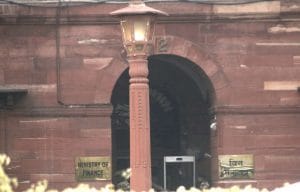






 Listen to the Article
Listen to the Article  Daily Newsletter
Daily Newsletter





